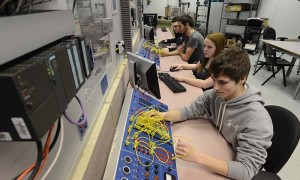I have some quick and easy professional development ideas to improve your lesson building skills. You can peruse ’em from the comfort of your lawn chair to ease the climb back into your classroom. Why? I think they’ll satisfy that thirst for improving your teaching skills without taking dollars from your pocket, and they won’t reduce your leisure time. Heck, you can even use ’em to fulfill your Professional Development Plan (PDP) for 2010!
Nope, what I’m suggesting is not languishing away in a classroom or even attending a vendor sponsored seminar. What I’m talking about is an hour or two a week – or less – in the comfort of your own schedule to consider improving the architecture of your instruction techniques. That’s correct, my intention is to have you grow these three core teaching abilities:
1. Classroom management skills: this influences every aspect of teaching for both new and experienced teachers.
2. Multimedia resources: time to start putting technology to work for you, in whatever capacity you have available in your classroom or school.
3. Pedagogy ideas: taking stock of what you’re doing and listening to the experts provides new window(s) for improving student performance.
Let’s be real, acquiring additional skills in these abilities makes you better equipped to capture student attention. When you’re doing that, you have engaged students, which means they’re more adept at building lifelong learner skills.
Capturing student interest is no mystery. I know this first hand from my high school teaching experiences. When students are interested in class material; student disruptions almost disappear and class time flies finer than the stealth bomber. Lesson material that works with digital students makes concepts relevant to life outside of class. Research shows this is best accomplished using hands on activities, integrating technology, creating and managing student collaboration, and accenting important ideas with video clips (15 minute maximum). As you raise the bar on your lesson making ability you demonstrate your commitment to excellence.
Like I said, all the resources I’m about to mention are absolutely free. Need software to be more productive? This package works on any computer and is in multiple languages; use it to make and distribute documents, slides, or spreadsheets: Open Office.
1. Tune up classroom management strategies
Without a solid set of classroom management skills, learning happens by luck. Effective teaching isn’t completed by winning personality contests or being the student’s buddy. Instead, learning occurs in a safe environment where students are curious and there is an atmosphere of respect. Just like a business has a set of rules and procedures to produce quality products for its’ customers, a teacher must have a clearly defined set rules and procedures to conduct class. An extensive set of ideas and procedures can be found at this scale of social competence site. Another source for some tips and techniques is this RSS feed, beware it also wants to sell you a book at the end. The Empower A Child blog has 10 excellent tips for teachers. On the left hand side of the Cooperative Learning Network page there are several useful articles worth your review. My favorite there is Teaching Social Skills. I had to adjust it somewhat for my high school class but those ideas definitely worked for me. Of course, The First Days of School, by Harry Wong, is the perfect resource for every teacher library. Every time I pick it up I select one or two new ideas to use with students.
2. Tweak your multimedia skills and resources
One picture is worth a thousand words. Images quickly validate obtuse concepts and put the brain in gear. For example, students may not get the verbal aspects of biotic and abiotic, but show ’em pictures of people, plants, and fire; now they have a window to apply what is being discussed. There are plenty of ways to use multimedia besides just using PowerPoint or slide presentations. Thinking is an essential ingredient learning at any age, using the Big 6 you gain a critical thinking resource and a web site that offers a ton of worksheets and presentations. Start using media kits to supplement your lesson resources. You can find one for any subject across the K12 curriculum by visiting the Orange County DOE site. Some other favorites of mine: listen to famous speeches, find any sound and download it, and then the perfect music to spice up classroom atmosphere or to add on your web page. If you, or your students, are going to be using online much at all you probably want an avatar. You can easily build one at YourManga and it’s available in multiple languages. The next step is exploding your video library resources. Use one of these qualified sites to fulfill your video cabinet with thousands of professional clips to enforce class concepts: National Geographic, Learner.org, and Teachers Domain. When you want to bring context of the past, present, and/or future to your class, check out the tons of streaming video (no downloads here) at TED and Fora TV, or scour How Stuff Works for material galore on any subject in an encyclopedia set.
3. Dust off your pedagogy schemes
Each educator has their own teaching style, refining that art of instruction never ends. Just like professional athletes always train to be on top of their game; superior educators look for ways to refine teaching methods. There are a couple of ways to accomplish this. One way is reading current research on education. The Internet Public Library (IPL) has an array of reading material on education reform and measurements and assessments. Another way is fine tuning the methods used to do actual instruction. One of the most comprehensive sites I’ve seen is provided by Intel. They’ve assembled substantial material to support building student collaboration in classes and improve student critical thinking skills. Project learning is a proven technique for getting students actively learning in classes. Eutopia provides a RSS feed with studies validating this methodology. They also have an extensive video catalog for educators covering a range of topics on effective K12 learning. The Global SchoolNet is a project exchange site. It’s a myriad of projects teachers and students have contributed from around the world. The content at Center for Innovation in Engineering and Science Education is aligned with math and science standards and it offers clearly defined projects. Their goal is to have classes use their projects to do cross-curriculum work. Students contribute from their local area, giving students in other areas an opportunity to learn about new areas while also exploring unique data contributions. At Merlot, teachers post their lessons and then get reviewed by peers. Covering all content areas, you can dig into high caliber lesson material for your new lesson or to revise an existing one. Another option is participating in a variety of quality academic communities.










